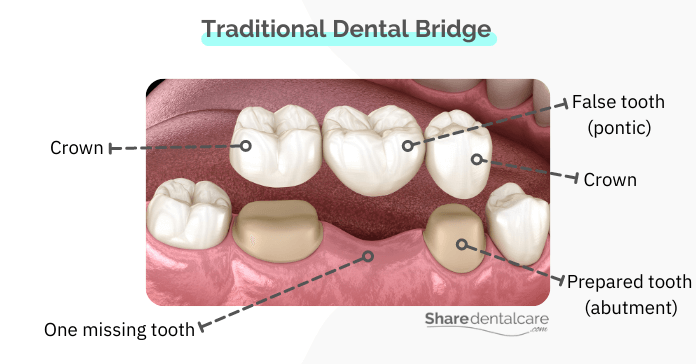Tooth loss can occur for a variety of reasons, including decay, gum disease, or injury. When you lose your teeth, it can have a major impact on your appearance and oral health, as well as your overall health. So, it’s important to replace missing teeth as soon as possible to avoid further problems. If you’ve lost a tooth, a dental bridge may be the right solution for you. They are a great way to restore your smile and improve your chewing function. In this blog post, we will discuss the dental bridge types and alternatives for replacing one missing tooth.
What’re Dental Bridges?
Dental bridges are fixed dental prostheses used to replace one or more missing teeth. Traditional bridges consist of a false tooth (or teeth) that is held in place by dental crowns that are placed on the adjacent natural teeth. The dental bridge is then cemented into place. Dental bridges can be made from porcelain, metal, or a combination of both.
Replacing one missing tooth with a dental bridge can help you:
- Get your smile and confidence back.
- Improve your chewing function and digestion.
- Prevent your remaining teeth from shifting out of position.
- Prevent dental problems resulting from tooth loss, such as gum disease and tooth decay.
Types of Dental Bridge for One Missing Tooth
If you have one missing tooth, you have three dental bridge types: traditional, cantilever, and Maryland bridges. The type of dental bridge that’s right for you will depend on the location of your missing tooth and the health of your adjacent teeth.
Traditional Dental Bridge for One Tooth
A traditional dental bridge is the most common type for replacing one missing tooth. It consists of a false tooth (or pontic) that is held in place by dental crowns that are placed on the adjacent natural teeth. The dental bridge is then cemented into place. Traditional bridges can be made from porcelain, metal, or a combination of both.
Traditional dental bridges can be used for replacing missing anterior or posterior teeth. However, they require the preparation of the adjacent teeth, which means that some of the tooth structures will be removed. This can weaken the teeth and make them more susceptible to dental problems in the future.

Cantilever Dental Bridge
A cantilever dental bridge is attached to only one side of the missing tooth. A cantilever bridge consists of a false tooth (or pontic) held in place by a dental crown or crowns that are placed on the adjacent teeth from only one side. The other side of the dental bridge is not attached to anything.
Cantilever dental bridges can be used for replacing teeth with low biting force, such as lateral incisors. However, cantilever bridges are not recommended for replacing molars because they can’t withstand high chewing forces. Cantilever bridges also place extra force on the adjacent teeth, which can lead to dental problems in the future.
Like traditional dental bridges, cantilever bridges require the preparation of adjacent teeth, which means that some of the tooth structures will be removed.
Maryland Dental Bridge
A Maryland dental bridge consists of one false tooth (or pontic) held in place by a metal framework (wings) bonded to the back of adjacent teeth. The framework is either made of metal or porcelain.
Maryland dental bridges are often used for replacing missing anterior teeth. They don’t require the preparation of adjacent teeth, which means that they don’t weaken the natural teeth. However, Maryland bridges can’t withstand high chewing forces and are not recommended for replacing posterior teeth.

Alternatives
While a dental bridge is a great way to replace one missing tooth, it is not the only option. Other dental prostheses, such as dental implants and dentures, can also be used. Your dentist will help you choose the best option for you based on your individual needs.
Dental implants are titanium posts that are surgically placed into the jawbone to support dental prostheses, such as dental crowns (teeth caps for adults). Dental implants are the strongest and most durable option for replacing missing teeth. However, they are also the most expensive option and require surgery.
Dentures are removable dental prostheses that can be used to replace one or more missing teeth. They are less expensive than dental bridges and implants, but they are also less durable and not as strong. A partial denture for 1 tooth is only recommended as a temporary solution.
You can read more about the different types of tooth replacement.
Dental Bridge for One Tooth – Conclusion
If you have one missing tooth, a dental bridge is a great way to replace it. There are many different types of dental bridges, such as traditional, cantilever, and Maryland bridges. Each type has its uses, advantages, and disadvantages. Your dentist will help you choose the best dental bridge for you based on your individual needs.
Traditional bridges are the most common type. They are strong and durable, but they require the preparation of adjacent teeth, which can weaken them. Dental implants are a great alternative to dental bridges. They are the strongest and most durable option for replacing missing teeth, but they are more expensive and require surgery. Talk to your dentist to see which option is best for you.